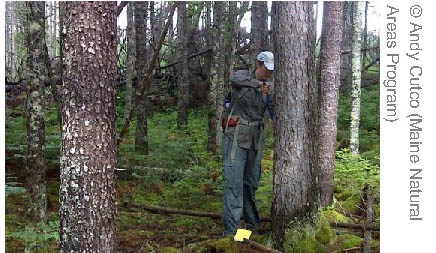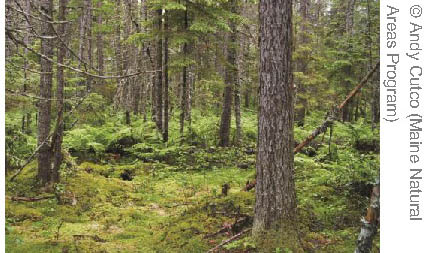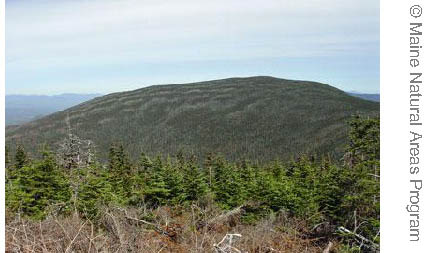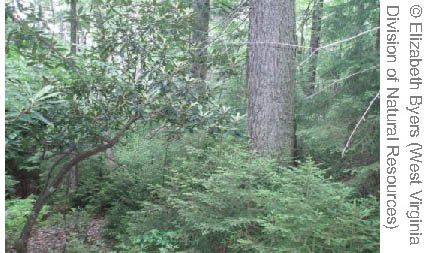The Boreal upland forest macrogroup consists of the following terrestrial habitat types:
Acadian Low Elevation Spruce-Fir Hardwood Forest

 Regional Distribution: MA, ME, NH, NY, VT. 5,522,851 total acres of habitat, of which 27.2% is conserved.
Regional Distribution: MA, ME, NH, NY, VT. 5,522,851 total acres of habitat, of which 27.2% is conserved.
Description: A low elevation conifer forest dominated by red spruce and balsam fir, often forming the matrix forest in colder parts of the Acadian and northern Appalachian region. Black and white spruce are sometimes present, along with yellow birch, paper birch, beech, and red or sugar maple, and northern white cedar in moister, richer locations. The shrub layer is sparse, and consists primarily of seedlings of principal tree species. Bryophytes are dominant in a dense herb layer. This habitat includes both cold pockets and depressions in hardwood mountains and large areas of seasonally wet flats, but not saturated conifer swamps. In succesional patches, paper birch, aspen, and larch are mixed in with the spruce and fir.
Download the pdf for this habitat for information about species, crosswalks to state names, and condition of this habitat.
Back toTerrestrial Habitats page | Back to Habitat Guideshomepage
pdf Guide for this habitat


Regional Distribution: MA, ME, NH, NY, VT. 1,513,068 total acres of habitat, of which 30.1% is conserved.
Description: A conifer or mixed forest forming extensive flats on areas of
imperfectly drained soils. Black spruce, red spruce, and
balsam fir dominate a mostly closed canopy; yellow birch,
hemlock, black cherry, and red maple are sometimes
present in smaller numbers. Bryophytes and low herbs are
abundant in the ground layer; the shrub layers are typically
sparse and made up principally of heath species. This forest
is characteristic of colder regions of the northern
Appalachians-Acadian region, where it often forms long
narrow patches along riverside flats in valley bottoms.


Regional Distribution: MA, ME, NH, NY, VT. 1,084,359 total acres of habitat, of which 67.4% is conserved.
Description: A high elevation conifer forest dominated by red spruce and balsam fir, and forming small to very large patches on the highest peaks of the northern Appalachian Mountains. Heart- leaved birch is a characteristic tree along with yellow birch, white birch, mountain maple, striped maple, mountains ash, and occasionally black spruce at upper patch edges. Canopy tree seedlings dominate the shrub layer, and small trees and shrubs are most prominent where landslides or fire have disturbed the system. Short, foggy summers, long and severe winters, and exposed locations define the ecology of this system. In this cold climate cloud forest, dense beds of sphagnum moss cover much of the forest floor, and lichens hang from the trees.
Download the
pdf guide for this habitat for information about species, crosswalks to state names, and condition of this habitat.


Regional Distribution: VA, WV. 64,954 total acres of habitat, of which 87.5% is conserved.
Description: A high elevation conifer forest dominated by red spruce and either Fraser fir (in very southwestern Virginia) or balsam fir (to the north). Mountain ash, yellow birch, hemlock, and red oak are locally common. Mosses, ferns, and forbs make up a typically lush ground cover; in many examples a dense shrub layer develops in which hobblebush and mountain cranberry, and occasionally evergreen rhododendrons, are prevalent. This is the characteristic forest of the cold, wet, windy highest peaks in the central and southern Appalachians. Some very large patches of this system remain, but unnatural fires fueled by logging slash turned large expanses of it into grass-shrub-hardwood scrub that has not recovered to conifer dominance after 90 years.